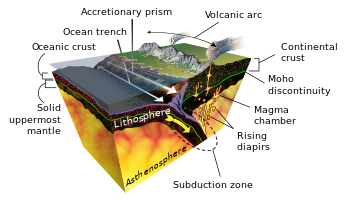
Back نطاق الانسياب Arabic Astenosfera AST Astenosfer Azerbaijani آستونوسفر AZB Астэнасфера Byelorussian Астэнасфэра BE-X-OLD Астеносфера Bulgarian एस्थेनोस्फीयर Bihari Astenosfera Catalan Astenosféra Czech

The asthenosphere (from Ancient Greek ἀσθενός (asthenós) 'without strength') is the mechanically weak[1] and ductile region of the upper mantle of Earth. It lies below the lithosphere, at a depth between c. 80 and 200 km (50 and 120 mi) below the surface, and extends as deep as 700 km (430 mi). However, the lower boundary of the asthenosphere is not well defined.
The asthenosphere is almost solid, but a slight amount of melting (less than 0.1% of the rock) contributes to its mechanical weakness. More extensive decompression melting of the asthenosphere takes place where it wells upwards, and this is the most important source of magma on Earth. It is the source of mid-ocean ridge basalt (MORB) and of some magmas that erupt above subduction zones or in regions of continental rifting.
- ^ Barrell, J. (1914). "The strength of the crust, Part VI. Relations of isostatic movements to a sphere of weakness – the asthenosphere". The Journal of Geology. 22 (7): 655–83. Bibcode:1914JG.....22..655B. doi:10.1086/622181. JSTOR 30060774. S2CID 224832862.